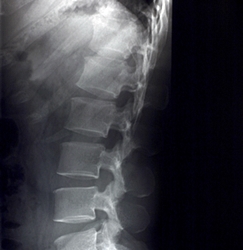20 May 2014. Techniques for regrowing new spinal disc cartilage tissue in the body from a person’s own skin cells received a patent from the U.S. Patent and Trademark Office. Patent number 8,728,495 was awarded today to inventors Lionel Sevrain and Sylvie Sevrain-Verdier and assigned to SpinalCyte LLC in Houston. Sevrain and Sevrain-Verdier are principals of SpinalCyte.
The patent covers SpinalCyte’s process for replacing degenerated spinal discs with new cartilage grown from a patient’s own human dermal fibroblasts, skin cells that can be regrown and cultured into different kinds of new tissue, including the cartilage that forms the core of discs that fit between vertebrae and cushion spinal movement. Degeneration of spinal discs, often a symptom of aging, leads to severe pain and can affect muscles and ligaments in the back. Current treatments usually involve removal of the damaged discs, sometimes with fusion of the remaining vertebrae, as well as painkiller drugs.
Some 13 million primary physician visits in the U.S. are related to chronic lower back pain, of which degenerated discs are a major cause. It is the largest contributor to lost productivity in the workplace, and second only to upper respiratory complaints as a cause of lost work time. In addition, disability from lower back pain increased 14 times the rate of population growth, and the greatest cause of disability among individuals age 45 and younger.
SpinalCyte’s invention includes the transformation of human skin cells into cartilage that acts as the core of a replacement disc, a bio-polymer scaffold that allows the the skin cells to transform and grow into replacement cartilage, and a balloon-like membrane housing for the new tissue to grow that fits into the three-dimensional space vacated by the damaged disc. The membrane and scaffold are made from bio-degradable materials that are absorbed into the body after regeneration of the disc.
The implanted device, according to the patent, acts as a bio-reactor where pressure from movement of the vertebrae helps the seeded skin cells grow around the scaffold into the new cartilage. The patent indicates the technology can also be applied to regenerating connective tissue in joints, such as the knee, elbow, shoulder, or hip.
Read more:
- Patent Awarded for Unwanted Internal Tissue Removal Device
- Engineered Cardiac Tissue Helps Veins Return Blood to Heart
- Patent Granted for RNA-Interference to Treat Scar Tissue
- Calif Stem Cell, UC Irvine Partner on Eye Transplant Tissue
- University, Biotech Develop Heart Tissue Repair Patch
* * *


 RSS - Posts
RSS - Posts
You must be logged in to post a comment.